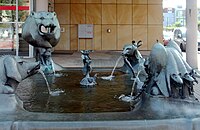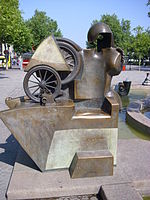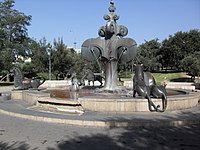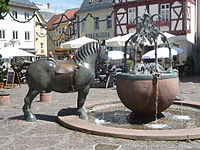Gernot Rumpf
- View a machine-translated version of the German article.
- Machine translation, like DeepL or Google Translate, is a useful starting point for translations, but translators must revise errors as necessary and confirm that the translation is accurate, rather than simply copy-pasting machine-translated text into the English Wikipedia.
- Do not translate text that appears unreliable or low-quality. If possible, verify the text with references provided in the foreign-language article.
- You must provide copyright attribution in the edit summary accompanying your translation by providing an interlanguage link to the source of your translation. A model attribution edit summary is
Content in this edit is translated from the existing German Wikipedia article at [[:de:Gernot Rumpf]]; see its history for attribution. - You may also add the template
{{Translated|de|Gernot Rumpf}}to the talk page. - For more guidance, see Wikipedia:Translation.
Gernot Rumpf | |
|---|---|
 Sculpture of Beamtenwecker (civil servants alarm clock), bronze, 1974/75, in front of ministry of culture and education, Mainz | |
| Born | 1941 (age 82–83) Kaiserslautern, Germany |
| Education | Academy of Fine Arts, Munich |
| Known for | sculpture |
Gernot Rumpf (born 1941) is a German sculptor known for his fountains and other bronze sculptures, with the Palatinate and biblical motifs. These can be seen not only in German cities, but also in Jerusalem and Tokyo. A part of his work came under the artistic collaboration of his wife Barbara Rumpf.
Education and work
Born in Kaiserlautern, Rumpf studied at the Academy of Fine Arts, Munich from 1964 until 1970 under the guidance of Josef Henselmann and Hans Ladner. In 1965 he opened his own workshop for bronze casting. 1967 to 1969 there was a further development supported by the Studienstiftung des deutschen Volkes (German National Academic Foundation).
In 1973 Rumpf received a teaching assignment from the Kaiserslautern University of Technology, that was converted in 1979 to a professorship. In 1980 and 1983 he held a visiting professorship at the International Summer Academy in Salzburg.
Selected works in public space
- 1973 (1973): Paradiesbrunnen, bronze, Kartoffelmarkt, Neustadt an der Weinstraße
- 1974 (1974): Glockenbaum, Beamtenwecker vernacular: civil servants alarm clock, bronze, in front of ministry of culture and education, Mainz
- 1984 (1984): Saint Ludger, bronze shrine, Essen-Werden St Ludger's basilica[1]
- 1985 (1985): Rossmarktbrunnen, bronze fountain, Alzey Rossmarkt[2]
- 1985 (1985): Geißbockbrunnen, depicts the Deidesheim billy goat auction, Deidesheim[3]
- 1989: Löwenbrunnen, Jerusalem
- 1990: Lederstrumpfbrunnen
- Rossmarktbrunnen, Alzey
-
 Weinbrunnen, Bad Bergzabern
Weinbrunnen, Bad Bergzabern - Papyrusbrunnen, Mannheim
-
 Paradiesbrunnen, Fürth
Paradiesbrunnen, Fürth -
 Elwetritschen-Brunnen ♧, Neustadt
Elwetritschen-Brunnen ♧, Neustadt -
 Löwenbrunnen, Jerusalem
Löwenbrunnen, Jerusalem
Literature
- Hans G. Hausen; Rudolf Joeckle (1981), Die Elwedritsche des Gernot Rumpf (in German), Neustadt an der Weinstraße: Pfälzische Verlagsanstalt
- Kunstkreis Viersen, ed. (1981), Gernot Rumpf und der Remigiusbrunnen in Viersen (in German), Viersen: Verlag Eckers, ISBN 3-923072-00-7
- Hans G. Hausen; Gerd Schattner (1990), Der Kaiser-Brunnen von Gernot Rumpf (in German), Konstanz: Verlag Hartung-Gorre, ISBN 3-89191-338-9
- Egon Ehmer; Karin Patock (1994), Herxheim. Geschichte und Leben rund um den Dorfbrunnen von Gernot und Barbara Rumpf (in German), Verlag Studio h, ISBN 3-931059-00-6
- Verein Südliche Weinstraße, ed. (1996), L'Atelier Mourlot. Gernot Rumpf – die Löwen von Jerusalem (in German), Landau: Ausstellungskatalog der 9. Weintage der Südlichen Weinstraße (Frank-Loebsches-Haus Landau in der Pfalz, 7. bis 10. Juni 1996)
- Hans G. Hausen (2000), Der Löwenbrunnen zu Jerusalem von Gernot und Barbara Rumpf (in German), Konstanz: Verlag Hartung-Gorre, ISBN 3-89649-518-6
- Wolfgang Schütz: Koblenzer Köpfe, Lebensbeschreibungen über Personen der Stadtgeschichte und Namensgeber für Straßen und Plätze, Mülheim-Kärlich (Verlag für Anzeigenblätter) o.J., ohne ISBN, Seite 310, Artikel "Rumpf, Professor Gernot", dort eine Kurzbiographie von Gernot Rumpf sowie eine Besprechung des von Gernot und Barbara Rumpf kreierten "Erfinderbrunnens" (im Koblenzer Volksmund auch "Arche Noah" genannt"), in der Fischelpassage.
References
External links
 Media related to Gernot Rumpf at Wikimedia Commons
Media related to Gernot Rumpf at Wikimedia Commons















